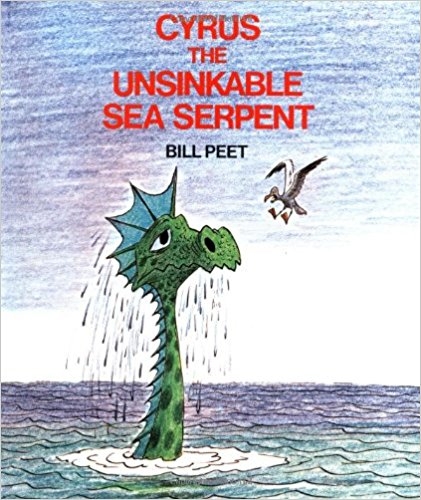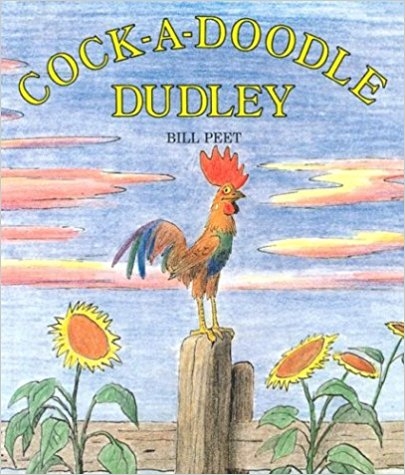Finding a children’s book author that speaks to your family is like stumbling upon a diamond mine. You enter their world and immediately feel right at home. The words flow how you imagine they should, and the illustrations are your tribe’s type of weird.
Bill Peet does that for us.
He lived the American dream, and his autobiography is as fascinating as his children’s books.  Born into poverty, he grew up poor in the 1920s, living through the Great Depression, then World War II. The book traces his life from his meager beginnings as a boy selling newspapers for a penny—he recounts the biggest headline he ever cried out was, “Lindbergh flies the Atlantic! Extra! Extra! Read all about it!”—through years of hard work, to eventually becoming one of the most well-loved children’s authors there ever was.
Born into poverty, he grew up poor in the 1920s, living through the Great Depression, then World War II. The book traces his life from his meager beginnings as a boy selling newspapers for a penny—he recounts the biggest headline he ever cried out was, “Lindbergh flies the Atlantic! Extra! Extra! Read all about it!”—through years of hard work, to eventually becoming one of the most well-loved children’s authors there ever was.
Some of us can probably identify when he writes about getting into trouble in grade school for doodling in his books. Years later, he was failing in college until he enrolled in art classes. To make a little money, he began entering paintings in local fairs. He once painted a still-life of a lantern, an old pair of boots, and a dead rat in a trap. It caused such disgusted reactions from the women, he kept creeping back over near it to amuse himself by listening to them gripe about his bad taste!
Eventually, Mr. Peet landed a job with Disney Studios as an artist, working long hours on the tedious task of drawing hundreds of fill-in pics.
Reading through this autobiography not only gives us a glimpse into Mr. Peet’s life, but it’s also an intriguing history lesson. He talks about how war changed what the Disney studios worked on, and he paints a vivid picture of Walt Disney the man, and what it was like to be part of some of the first animated classics they made. He worked on Snow White, Pinocchio, and Fantasia, and was responsible for a large part of the creation of 101 Dalmatians, Dumbo and several other films. He even gave some of the personal stories he had written to Disney, to be made into animated shorts and Golden books.
After 27 years, Bill Peet left Disney to focus on his true passion, writing and illustrating children’s books.
His stories often teach a moral lesson or have a strong underlying message, while his illustrations are amazing works of artistic genius. Animals were an obvious passion, and the way he wields his pen to suddenly draw you in (pun intended!) will have the most restless child spellbound. He brings even inanimate objects to life with a most captivating creativity.
As a boy growing up, he loved to spend time in the woods and creek. He cared for the environment and was saddened by the pollution he witnessed pouring into the creek bed. He devoted at least two of his books to this issue. One is titled The Caboose Who Got Loose, and the other, The Wump World.


In the first book, a sad little caboose named Katy longs to live in the woods, but is destined to be dragged around at the end of a coal train choking on smoke. The latter story describes the peace-loving Wumps who are invaded by alien Pollutians. The aliens quickly begin to destroy the Wump world with all their “advanced technology” and send the Wumps fleeing underground for safety. Do the Pollutians take control and over-run the Wumps? What happens to the Wumps? Will they survive? Although it’s a simple children’s story, the message of taking care of our environment runs deep—it was a problem when Mr. Peet wrote his books, and one that we clearly still face today.
In another book, Cyrus the Unsinkable Sea Serpent, the author spins a fantastical yarn about a gentle sea monster who is teased for being a sissy. He determines to go out and destroy a ship to prove he isn’t. Along the way, he encounters the Primrose in perilous circumstances, and a ferocious pirate crew. Your child will fall in love with this character as Cyrus struggles to choose between his desire to be accepted for who he is, or changing to fit someone else’s perception of what a sea serpent should be.
The author has a whimsical way of taking the real struggles children encounter every day, and weaving them into his animal characters. The Ant and the Elephant and Cock-A-Doodle Dudley both have despicably rude animals in need of some manners and kindness, who find out being mean to others doesn’t make them happy, after all.


Bill Peet wrote over 30 books. Although I’ve yet to collect them all, they are definitely on my keep-my-eyes-peeled list. Next time you head to your local library, be sure to look for Bill Peet’s books, then curl up with your favorite child and enjoy a good laugh together!
